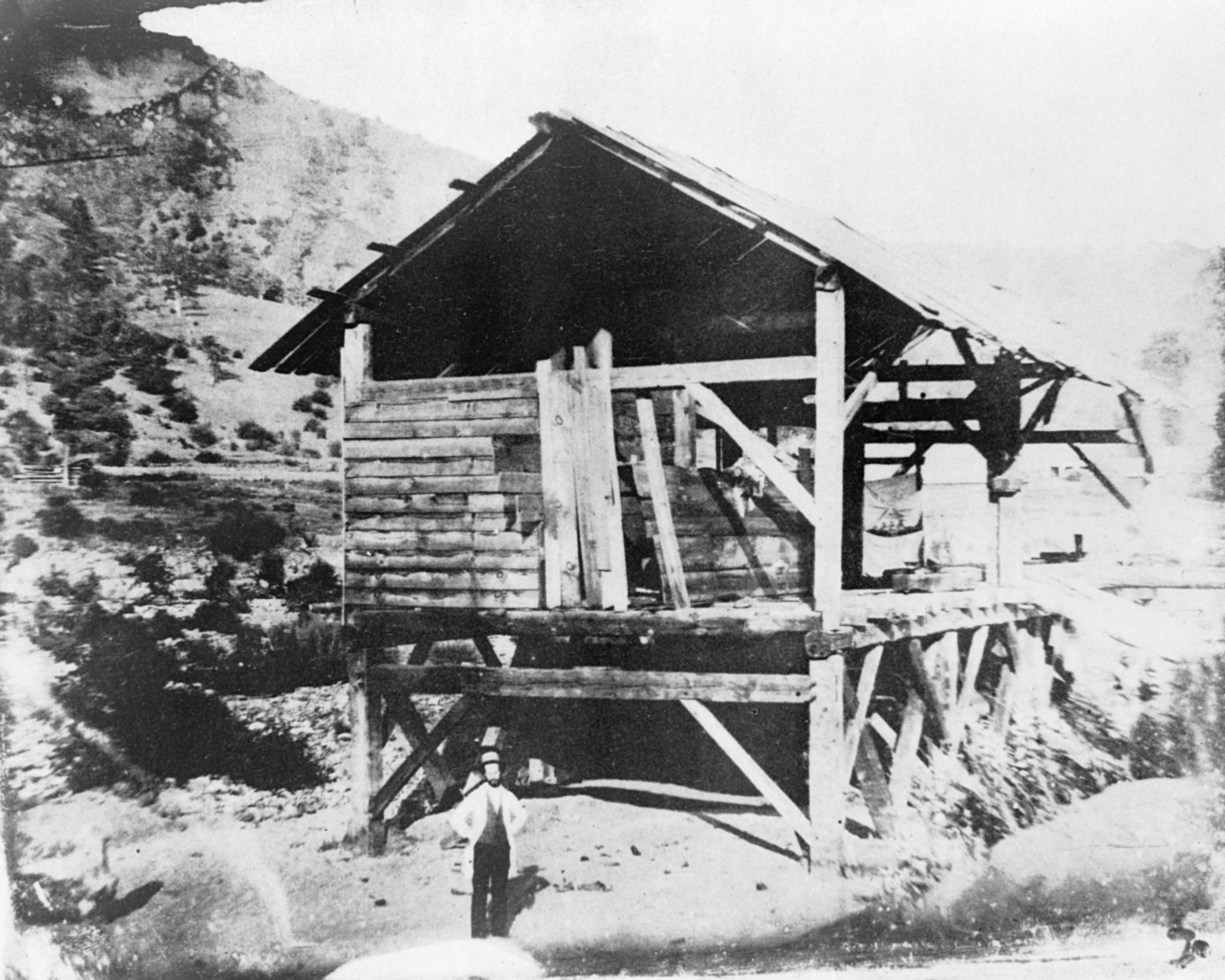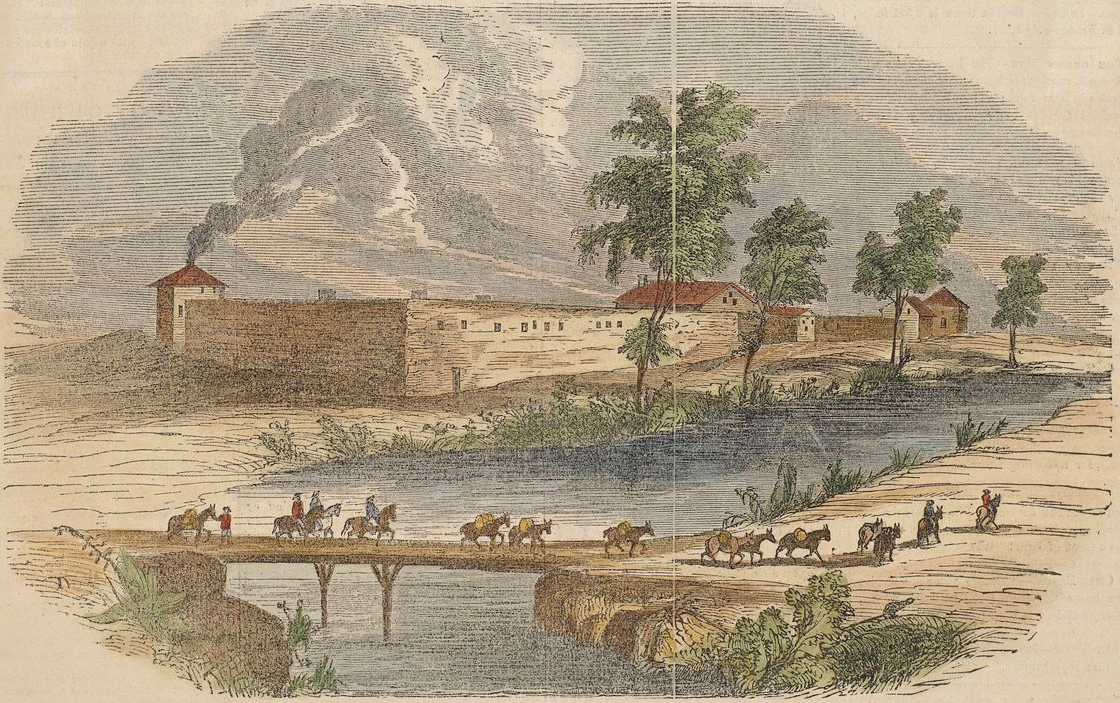|
James W. Marshall
James Wilson Marshall (October 8, 1810 – August 10, 1885) was an American carpenter and sawmill operator, who on January 24, 1848 reported the finding of gold at Coloma, California, a small settlement on the American River about 36 miles northeast of Sacramento. His discovery was the impetus for the California Gold Rush. The mill property was owned by John Sutter, Johann (John) Sutter who employed Marshall to build Sutter's Mill, his mill. The wave of gold seekers turned everyone's attention away from the mill which eventually fell into disrepair and was never used as intended. Neither Marshall nor Sutter ever profited from the gold find. Biography James Wilson Marshall, of English people, English descent, was born to Philip Marshall and Sarah Wilson (married 1808) at the family homestead in Hopewell Township, Mercer County, New Jersey, Hopewell Township, New Jersey (then part of Hunterdon County, New Jersey, currently part of Mercer County, New Jersey, Mercer County) on Oct ... [...More Info...] [...Related Items...] OR: [Wikipedia] [Google] [Baidu] |
Hopewell Township, Mercer County, New Jersey
Hopewell Township is a Township (New Jersey), township in Mercer County, New Jersey, Mercer County, New Jersey, United States. Located within the Raritan River, Raritan Valley region, the township is an exurb of New York City in the New York metropolitan area as defined by the United States Census Bureau, while also directly bordering the Delaware Valley, Philadelphia metropolitan area, being a part of the Federal Communications Commission's Philadelphia Designated Market Area.- Philadelphia Market Area Coverage Maps Federal Communications Commission. Accessed December 28, 2014. As of the 2020 United States census, the township's population was 17,491, an increase of 187 (+1.1%) from the 2010 United States census, 2010 census count o ... [...More Info...] [...Related Items...] OR: [Wikipedia] [Google] [Baidu] |
Indiana
Indiana () is a U.S. state in the Midwestern United States. It is the 38th-largest by area and the 17th-most populous of the 50 States. Its capital and largest city is Indianapolis. Indiana was admitted to the United States as the 19th state on December 11, 1816. It is bordered by Lake Michigan to the northwest, Michigan to the north, Ohio to the east, the Ohio River and Kentucky to the south and southeast, and the Wabash River and Illinois to the west. Various indigenous peoples inhabited what would become Indiana for thousands of years, some of whom the U.S. government expelled between 1800 and 1836. Indiana received its name because the state was largely possessed by native tribes even after it was granted statehood. Since then, settlement patterns in Indiana have reflected regional cultural segmentation present in the Eastern United States; the state's northernmost tier was settled primarily by people from New England and New York, Central Indiana by migrants fro ... [...More Info...] [...Related Items...] OR: [Wikipedia] [Google] [Baidu] |
League (unit)
A league is a unit of length. It was common in Europe and Latin America, but is no longer an official unit in any nation. Derived from an ancient Celtic unit and adopted by the Romans as the ''leuga'', the league became a common unit of measurement throughout western Europe. It may have originally represented, roughly, the distance a person could walk in an hour. Since the Middle Ages, many values have been specified in several countries. Different definitions Ancient Rome The league was used in Ancient Rome, defined as 1½ Roman miles (7,500 Roman feet, modern 2.2 km or 1.4 miles). The origin is the ''leuga Gallica'' ''(also: leuca Callica)'', the league of Gaul. Argentina The Argentine league (''legua'') is or 6,666 ''varas'': 1 ''vara'' is . English-speaking world On land, the league is most commonly defined as three miles (4.83km), though the length of a mile could vary from place to place and depending on the era. At sea, a league is . English usage also ... [...More Info...] [...Related Items...] OR: [Wikipedia] [Google] [Baidu] |
Mexico
Mexico (Spanish: México), officially the United Mexican States, is a country in the southern portion of North America. It is bordered to the north by the United States; to the south and west by the Pacific Ocean; to the southeast by Guatemala, Belize, and the Caribbean Sea; and to the east by the Gulf of Mexico. Mexico covers ,Mexico ''''. . making it the world's 13th-largest country by are ... [...More Info...] [...Related Items...] OR: [Wikipedia] [Google] [Baidu] |
Alcalde
Alcalde (; ) is the traditional Spanish municipal magistrate, who had both judicial and administrative functions. An ''alcalde'' was, in the absence of a corregidor, the presiding officer of the Castilian '' cabildo'' (the municipal council) and judge of first instance of a town. ''Alcaldes'' were elected annually, without the right to reelection for two or three years, by the ''regidores'' (council members) of the municipal council. The office of the ''alcalde'' was signified by a staff of office, which they were to take with them when doing their business. A woman who holds the office is termed an ''Alcaldesa''. In New Spain (Mexico), ''alcaldes mayores'' were chief administrators in colonial-era administrative territories termed ''alcaldías mayores''; in colonial-era Peru the units were called ''corregimientos''. ''Alcalde'' was also a title given to Indian officials inside the Spanish missions, who performed a large variety of duties for the Franciscan missionaries. M ... [...More Info...] [...Related Items...] OR: [Wikipedia] [Google] [Baidu] |
New Helvetia
New Helvetia (Spanish: Nueva Helvetia), meaning "New Switzerland", was a 19th-century Alta California settlement and Ranchos of California, rancho, centered in present-day Sacramento, California, Sacramento, California. Colony of Nueva Helvetia The Swiss people, Swiss pioneer John Sutter (1803–1880) arrived in Alta California with other Euro-American settlers in August 1839. He established an agricultural and trading colony, with the stockade Sutter's Fort, and named it "Nueva Helvetia." It was located at the confluence of the Sacramento River and American River. In English the name means "New Switzerland", after Sutter's home country. The design was influenced by Bents Fort operated by the William Bent, which Sutter visited before entering Alta California, Richard. The site of "Nueva Helvetia" is just a few miles east of where his son, John Augustus Sutter, Jr., John Sutter, Jr., established Sacramento, California, Sacramento, and is on the eastern edge of present-day downto ... [...More Info...] [...Related Items...] OR: [Wikipedia] [Google] [Baidu] |
Sutter's Fort
Sutter's Fort was a 19th-century agricultural and trade colony in the Mexican ''Alta California'' province.National Park Service"California National Historic Trail."/ref> The site of the fort was established in 1839 and originally called New Helvetia (''New Switzerland'') by its builder John Sutter, though construction of the fort proper would not begin until 1841. The fort was the first non-indigenous community in the California Central Valley. The fort is famous for its association with the Donner Party, the California Gold Rush, and the formation of the city of Sacramento, surrounding the fort. It is notable for its proximity to the end of the California Trail and Siskiyou Trails, which it served as a waystation. After gold was discovered at Sutter's Mill (also owned by John Sutter) in Coloma on January 24, 1848, the fort was abandoned. The adobe structure has been restored to its original condition and is now administered by California Department of Parks and Recreation. It ... [...More Info...] [...Related Items...] OR: [Wikipedia] [Google] [Baidu] |
Siskiyou Trail
The Siskiyou Trail stretched from California's Central Valley to Oregon's Willamette Valley; modern-day Interstate 5 follows this pioneer path. Originally based on existing Native American foot trails winding their way through river valleys, the Siskiyou Trail provided the shortest practical travel path between early settlements in California and Oregon. Development The earliest European or European-American visitors along the Siskiyou Trail were likely hunters and trappers connected with the Hudson's Bay Company (HBC) who, in the 1820s, began to travel the rivers of Southern Oregon and Northern California in search of fur and pelts. The HBC had established itself on the Columbia River, and built Fort Vancouver, its regional headquarters in 1824. HBC parties began to explore south toward California in 1825. Alexander McLeod led exploration and trapping parties south beginning in 1826, reaching the Klamath River in 1827, and the Sacramento River in 1828. In 1829 he led the firs ... [...More Info...] [...Related Items...] OR: [Wikipedia] [Google] [Baidu] |
Willamette Valley
The Willamette Valley ( ) is a long valley in Oregon, in the Pacific Northwest region of the United States. The Willamette River flows the entire length of the valley and is surrounded by mountains on three sides: the Cascade Range to the east, the Oregon Coast Range to the west, and the Calapooya Mountains to the south. The valley is synonymous with the cultural and political heart of Oregon and is home to approximately 70 percent of its population including the five largest cities in the state: Portland, Eugene, Salem, Gresham, and Hillsboro. The valley's numerous waterways, particularly the Willamette River, are vital to the economy of Oregon, as they continuously deposit highly fertile alluvial soils across its broad, flat plain. A massively productive agricultural area, the valley was widely publicized in the 1820s as a "promised land of flowing milk and honey." Throughout the 19th century, it was the destination of choice for the oxen-drawn wagon trains of emigr ... [...More Info...] [...Related Items...] OR: [Wikipedia] [Google] [Baidu] |
Oregon
Oregon () is a U.S. state, state in the Pacific Northwest region of the Western United States. The Columbia River delineates much of Oregon's northern boundary with Washington (state), Washington, while the Snake River delineates much of its eastern boundary with Idaho. The 42nd parallel north, 42° north parallel delineates the southern boundary with California and Nevada. Oregon has been home to many Indigenous peoples of the Americas, indigenous nations for thousands of years. The first European traders, explorers, and settlers began exploring what is now Oregon's Pacific coast in the early-mid 16th century. As early as 1564, the Spanish expeditions to the Pacific Northwest, Spanish began sending vessels northeast from the Philippines, riding the Kuroshio Current in a sweeping circular route across the northern part of the Pacific. In 1592, Juan de Fuca undertook detailed mapping and studies of ocean currents in the Pacific Northwest, including the Oregon coast as well as ... [...More Info...] [...Related Items...] OR: [Wikipedia] [Google] [Baidu] |
Malaria
Malaria is a mosquito-borne infectious disease that affects humans and other animals. Malaria causes symptoms that typically include fever, tiredness, vomiting, and headaches. In severe cases, it can cause jaundice, seizures, coma, or death. Symptoms usually begin ten to fifteen days after being bitten by an infected mosquito. If not properly treated, people may have recurrences of the disease months later. In those who have recently survived an infection, reinfection usually causes milder symptoms. This partial resistance disappears over months to years if the person has no continuing exposure to malaria. Malaria is caused by single-celled microorganisms of the ''Plasmodium'' group. It is spread exclusively through bites of infected ''Anopheles'' mosquitoes. The mosquito bite introduces the parasites from the mosquito's saliva into a person's blood. The parasites travel to the liver where they mature and reproduce. Five species of ''Plasmodium'' can infect and be spread by h ... [...More Info...] [...Related Items...] OR: [Wikipedia] [Google] [Baidu] |







.jpg)
